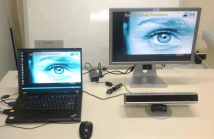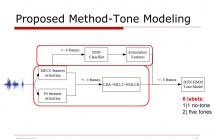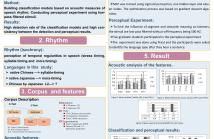
Welcome to ISCSLP 2016 - October 17-20, 2016, Tianjin, China
The ISCSLP will be hosted by Tianjin University. Tianjin has a reputation throughout China for being extremely friendly, safe and a place of delicious food. Welcome to Tianjin to attend the ISCSLP2016. The 10th International Symposium on Chinese Spoken Language Processing (ISCSLP 2016) will be held on October 17-20, 2016 in Tianjin. ISCSLP is a biennial conference for scientists, researchers, and practitioners to report and discuss the latest progress in all theoretical and technological aspects of spoken language processing. While the ISCSLP is focused primarily on Chinese languages, works on other languages that may be applied to Chinese speech and language are also encouraged. The working language of ISCSLP is English.
- Read more about Speaker Diarization System for Autism Children’s Real-Life Audio Data
- Log in to post comments
- Categories:
 16 Views
16 Views- Read more about Prosodic Annotation Enriched Statistical Machine Translation
- Log in to post comments
More and more linguistic information has been employed to improve the performance of machine translation, such as part of speech, syntactic structures, discourse contexts, and so on. However, conventional approaches typically ignore the key information beyond the text such as prosody. In this paper, we exploit and employ three prosodic features: pronunciation (phonetic alphabet and tone), prosodic boundaries and emphasis.
- Categories:
 4 Views
4 Views
- Read more about Evaluation of a multimodal 3-d pronunciation tutor for learning Mandarin as a second language: an eye-tracking study
- Log in to post comments
- Categories:
 8 Views
8 Views
- Read more about Acoustic Correlates and Gender Effects in Production and Perception of Japanese Polite Speech
- Log in to post comments
This study examines potential contribution of prosodic features and voice quality to the perception and production of Japanese polite speech as well as possible gender effects in politeness strategy.
Shi Shuju, Tsurutani Chiharu, Feng Xiaoli, Zhang Jinsong, Minematsu Nobuaki
- Categories:
 6 Views
6 Views
- Read more about Improving Mandarin Tone Recognition Based on DNN by Combining Acoustic and Articulatory Features
- Log in to post comments
- Categories:
 33 Views
33 Views- Read more about Evaluation of a multimodal 3-d pronunciation tutor for learning Mandarin as a second language: an eye-tracking study
- Log in to post comments
- Categories:
 3 Views
3 Views- Read more about Automatic Mandarin Prosody Boundary Detecting Based on Tone Nucleus Features and DNN Model
- Log in to post comments
- Categories:
 14 Views
14 Views- Read more about A Linguistic Annotation Scheme of Chinese Discourse Structures and Study of Prosodic Interaction
- Log in to post comments
Speech discourse comprehension is crucial for developing intelligent speech processing technologies. The present research aims to establish a multi-layered annotation scheme for Chinese discourse that contains inter-related information of phonetics, phonology, syntax, semantics and pragmatics. This research provides a theoretical foundation and analytical support for discourse comprehension by examining and modelling the relationships between prosody and morphology-syntax, as well as semantics and other structures during speech interactions.
- Categories:
 20 Views
20 Views
- Read more about Automatic Detection of Rhythmic Patterns in Native and L2 Speech: Chinese, Japanese, and Japanese L2 Chinese
- Log in to post comments
This study explores possible contribution of speech rhythm to foreign accent. We conducted statistical analysis and realized automatic detection of rhythmic patterns on Mandarin Chinese, Japanese and Japanese second language learners (L2) of Chinese using interval-based and amplitude-based measures.
rhythm.pdf
- Categories:
 12 Views
12 Views